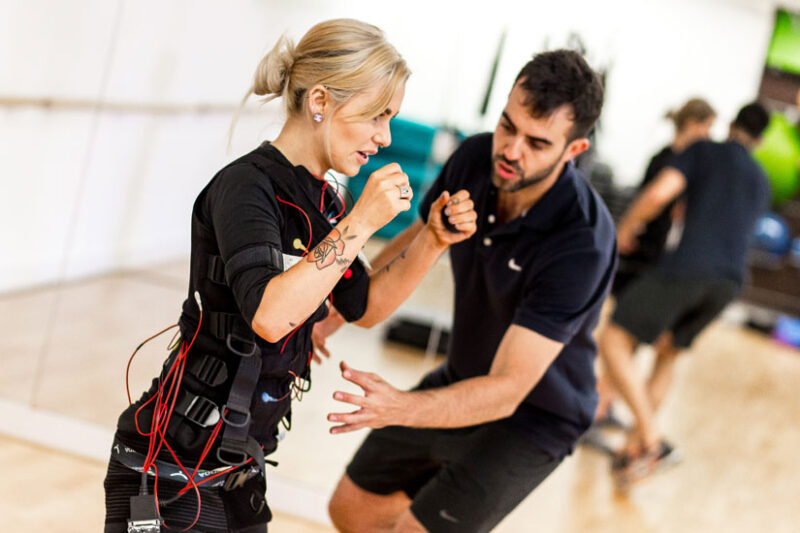Electrical Muscle Stimulation (EMS) training is rapidly gaining traction as a cutting-edge fitness technique. By using electrical impulses to provoke muscle contraction, it complements traditional exercise methods, promising enhanced muscle strength, accelerated fat loss, and a highly efficient workout experience. Given its effectiveness and growing popularity, a critical question arises for both novices and seasoned fitness enthusiasts alike: What is the optimal frequency for EMS training to reap the maximum benefits, avoid overtraining, and ensure sustained progress?
Benefits of EMS Training

EMS training is distinguished by its unique ability to offer substantial benefits within a condensed timeframe, making it an ideal choice for those seeking efficient and effective workout solutions. It significantly enhances muscle strength, promotes fat loss, and improves overall body composition through targeted muscle group activation. This specificity allows for a focused approach to fitness, enabling individuals to achieve more pronounced results compared to traditional workouts. EMS’s capacity to directly stimulate muscle fibers contributes to its effectiveness, presenting an advantageous option for enhancing physical performance, accelerating recovery, and achieving tailored fitness goals.
Factors Influencing Training Frequency
The optimal frequency of EMS training sessions is influenced by a constellation of factors, each playing a pivotal role in crafting a personalized regimen. Foremost among these is the individual’s set of fitness goals—ranging from muscle gain and fat reduction to enhanced overall fitness. Equally important is the user’s current fitness level and prior experience with EMS training, as these elements dictate the body’s adaptability and responsiveness to electrical stimulation. Recovery time is another critical consideration; the intensity of EMS workouts necessitates adequate rest periods to prevent muscle soreness and ensure full recovery, thereby influencing the advisable frequency of sessions. Balancing these factors is essential for devising an effective, sustainable EMS coaching schedule that maximizes benefits while minimizing risks.
Beginner’s Guide to EMS Frequency
For those new to EMS training it might be best to start with professionals such as TrainWithUS. Moderate approach is key to maximizing benefits while allowing the body to adjust to this new form of exercise. Initially, undertaking 1-2 sessions per week is recommended, providing a balance between practice intensity and necessary recovery time. This frequency supports the body’s adaptation process, minimizes the risk of muscle soreness, and lays a solid foundation for future progress. Incorporating rest days is crucial to facilitate recovery, prevent overtraining, and ensure that muscles have sufficient time to repair and strengthen. As beginners become more comfortable and their bodies more accustomed to EMS coaching, adjustments to frequency and intensity can be made, always with an eye toward optimal health and performance.
Intermediate Level

Once individuals have navigated the initial phase and built a foundation with EMS training, increasing the frequency to 2-3 sessions per week may be beneficial. This progression allows for a greater stimulus on the muscles, encouraging further strength gains and body composition improvements. At this stage, the importance of gradually increasing intensity and duration becomes paramount, ensuring continuous advancement without overburdening the body. Careful monitoring of recovery and response to practice is essential, as it allows for adjustments to be made, ensuring that the increased frequency contributes positively to achieving fitness goals. Balancing workout intensity, frequency, and recovery is crucial for intermediate users to continue reaping the benefits of EMS training without succumbing to overtraining.
Advanced Level
For advanced practitioners of EMS training, exploring more frequent sessions, such as 3-4 per week, may be appropriate, provided that careful attention is paid to the body’s signals. This level of frequency can offer enhanced benefits, including maximized muscle stimulation, increased strength, and further fat loss. However, it also raises the risk of overtraining, making it imperative for individuals to listen closely to their bodies and adjust their regimen accordingly. Advanced users must prioritize recovery, recognizing that the quality of training sessions often outweighs quantity. Tailoring the frequency to one’s personal recovery capacity, fitness level, and goals is essential at this advanced stage to ensure ongoing progress and prevent setbacks.
Specific Goals and Frequency
Adjusting the frequency of EMS training should be tailored to individual fitness goals. For muscle gain, focusing on fewer, more intense sessions with ample recovery time proves most effective. In contrast, weight loss goals might benefit from a slightly increased frequency, ensuring each session is utilized to its maximum fat-burning potential. Those seeking general fitness improvements may find a balanced approach—moderating between intensity and frequency—most beneficial. Ultimately, the key lies in customizing the practice frequency to align with specific objectives, taking into account the body’s response and the principles of progressive overload and recovery.
Lifestyle Considerations

Lifestyle factors play a significant role in determining the feasible frequency of EMS training sessions. Work schedules, family commitments, and other exercise routines must be considered when planning EMS sessions to ensure they complement rather than complicate daily life. An adaptable approach, which integrates EMS training into existing routines without causing stress or overcommitment, is crucial. This balance ensures that training remains a sustainable and enjoyable part of one’s lifestyle, contributing positively to overall wellbeing and fitness goals.
Monitoring Progress
Regularly tracking progress is essential when engaging in EMS training. Monitoring changes in strength, body composition, and general fitness levels helps in assessing the effectiveness of the current frequency of sessions and making necessary adjustments. Awareness of signs of overtraining, such as persistent fatigue, decreased performance, or increased susceptibility to injuries, is crucial. Recognizing these signals early enables individuals to appropriately scale back their training frequency, ensuring long-term health and progress towards their fitness goals.
Professional Guidance
Seeking advice from a qualified fitness trainer or EMS specialist is invaluable for tailoring an EMS training regimen to individual needs and goals. Professional guidance ensures that training plans are scientifically grounded, safe, and optimized for results. Specialists can provide insights into the most effective frequencies, intensities, and recovery strategies, making personalized recommendations that enhance the benefits of EMS training while safeguarding against potential risks.
Safety Precautions
Adhering to safety guidelines and proper use of EMS technology is paramount to prevent overuse injuries or adverse effects. Users should ensure they are familiar with their EMS device, following manufacturer instructions and professional advice for safe operation. It’s important to recognize the limits of one’s body and the technology, avoiding the temptation to exceed recommended frequencies or intensities that could lead to muscle strain or other injuries.
Conclusion
Finding the right frequency for EMS training is a dynamic process that requires careful consideration of individual goals, fitness levels, and lifestyle factors. Starting conservatively and gradually increasing frequency allows for adaptation and growth, ensuring the body responds positively to EMS stimuli. By listening to the body, incorporating professional advice, and adjusting as necessary, individuals can optimize their EMS training frequency for maximum effectiveness and sustainability. Experimentation and attentiveness to one’s physical responses are key in unlocking the full potential of EMS training, paving the way for enhanced fitness and wellbeing.














